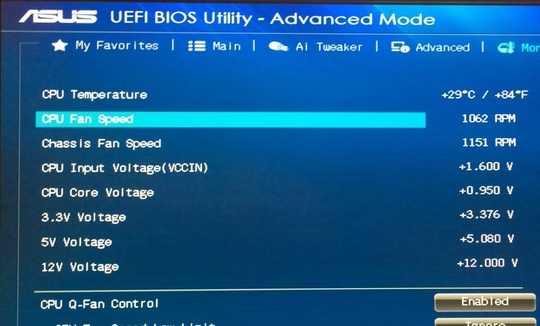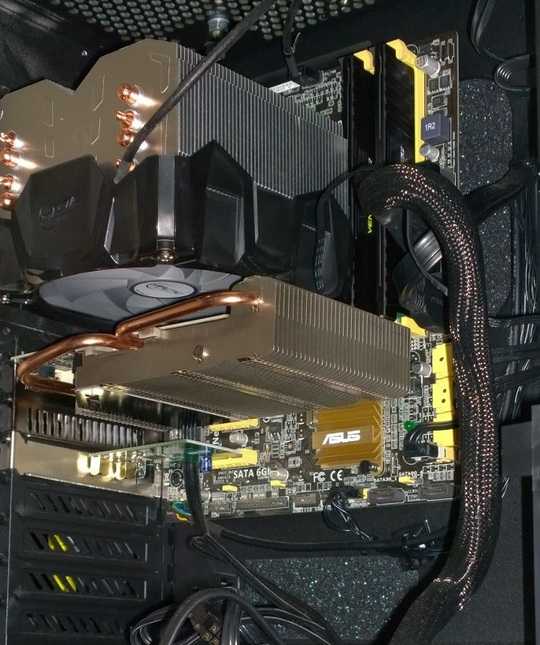13
1
I have a desktop PC that is just over a year old that I use daily for work. It's running Windows 8.1, has 16GB RAM and an i7 CPU. It has a 256GB Samsung 840 SSD (Windows + programs) along with a 1TB Seagate HDD (documents). The motherboard is an ASUS B85M-G. The graphics card is a 2GB ZOTAC GT640, with two monitors attached.
As of Friday last week it is shutting down (without warning) after 30 minutes of uptime. I have not installed any new hardware recently, nor installed any new software (other than whatever Windows updates came along last week).
By "shutdown" I mean that it is as if the power cable was pulled from the PC. Screen goes blank, cooling fans stop spinning, and I can hear a "ping" from the 1TB HDD as the drive head parks.
Initial speculation suggested that this was a classic PSU issue, so I obtained a replacement power supply and plugged that in this morning. Same problem.
While in Windows I have run temperature monitoring software that shows that the CPU cores are happily down at around 40°C, and the GPU is at a similar temperature. The innards of the PC are clean and free of dust, and all fans are spinning.
BIOS reports that CPU temperature, fan speeds and voltages are fine:

Following a shutdown and restart I've inspected the Windows event logs, but have not found anything that explains the shutdown, only a log entry that says that Windows was not shut down properly.
I have also discovered that the problem persists if I just enter the system BIOS on boot and let the PC sit there for half an hour (so it's not a Windows issue...)
I have upgraded the BIOS since I bought the PC, but this was back in May.
I have checked the RAM using Memtest86+, this reported no issues but sadly was only able to get about 60% of the way through before the PC shutdown.
For what it's worth, there is very little clearance between the heat sink on the passively-cooled graphics card and the RAM. However the heat sink is generally cool to the touch. There is also not much clearance between the CPU heat sink fan and the graphics card, but again temperatures are fine. Photo below illustrates the internals...

Can anyone suggest what might be going on here?
Edit - Troubleshooting progress
Since originally posting this question I've tried the following in an attempt to isolate the issue. In all cases the PC still shutdown after 30 minutes:
- Unplugged optical drive, entered BIOS screen
- Removed graphics card, allowed to boot to windows (presumably, as I remembered I'd previously disabled onboard graphics in BIOS so couldn't get a picture on my monitor
- Replaced graphics card with another, unplugged all USB devices apart from mouse and keyboard, entered BIOS screen
- Unplugged SSD and HDD, entered BIOS screen
- Removed backup battery for BIOS, waited half an hour, put battery still in. Booted and went to BIOS screen
1In BIOS, do you have a Hardware/Temperature Monitor? What are the temperatures just before shutting down? – Cornelius – 11 years ago
1Have you checked the event logs? – DavidPostill – 11 years ago
Inspect capacitors on motherboard, are they bloated or deformed? – Basilevs – 11 years ago
@DavidPostill - forgot to mention event logs in my question, just updated it to note that there's nothing in them (that I can see) that explains the shutdown. Note also that this shutdown happens even when I leave the PC in the BIOS setting screen. I don't think it's Windows-related. – Richard Ev – 11 years ago
@Basilevs - capacitors all look good. – Richard Ev – 11 years ago
2Ah, important ones are usually near north bridge, which is covered with your cooling system :( – Basilevs – 11 years ago
@Basilevs - Just running a test with optical drive removed (process of peripheral elimination...?) so will try to get a view of those capacitors later. If I unclip the CPU cooling fan should they be visible? – Richard Ev – 11 years ago
Yes, take that as a final step. No radiators seem to still be in the way. – Basilevs – 11 years ago
3How do you define 'shutdown', does the PSU turn itself off, does the standby power turn off as well? And is it after about 30 min, or after exactly 30 minutes? – AVee – 11 years ago
Is that CPU fan&heatsink oriented correctly? The fan is facing the backside of the graphics card? That would increase the static pressure that the fan sees. Normally the fan would face the front of the case, and blow towards the back. I realize that you mentioned that temps seemed okay, but this unusual config may cause the fan to draw a bit more current. – sawdust – 11 years ago
@sawdust - the shutdown still happens even with no graphics card present (so plenty of space around the CPU fan). That said, I am intending to orient the heatsink as you suggest later this week. – Richard Ev – 11 years ago
1It looks like there are two banks of memory in there, pulling one out and trying again might be a useful test (try both separately). Resetting your bios to factory defaults seems useful, there could even be a shutdown timer in there or some standby issue. And pull the plugs going to your case, power, reset etc. A flaky button could also cause issues. Either pull the plug for the power button after turning it on, or turn it on by shorting the two pins connected to the power button with a screwdriver. And grab a stopwatch, see if it's exactly 30 minutes, in that case it's likely a bios issue. – AVee – 11 years ago